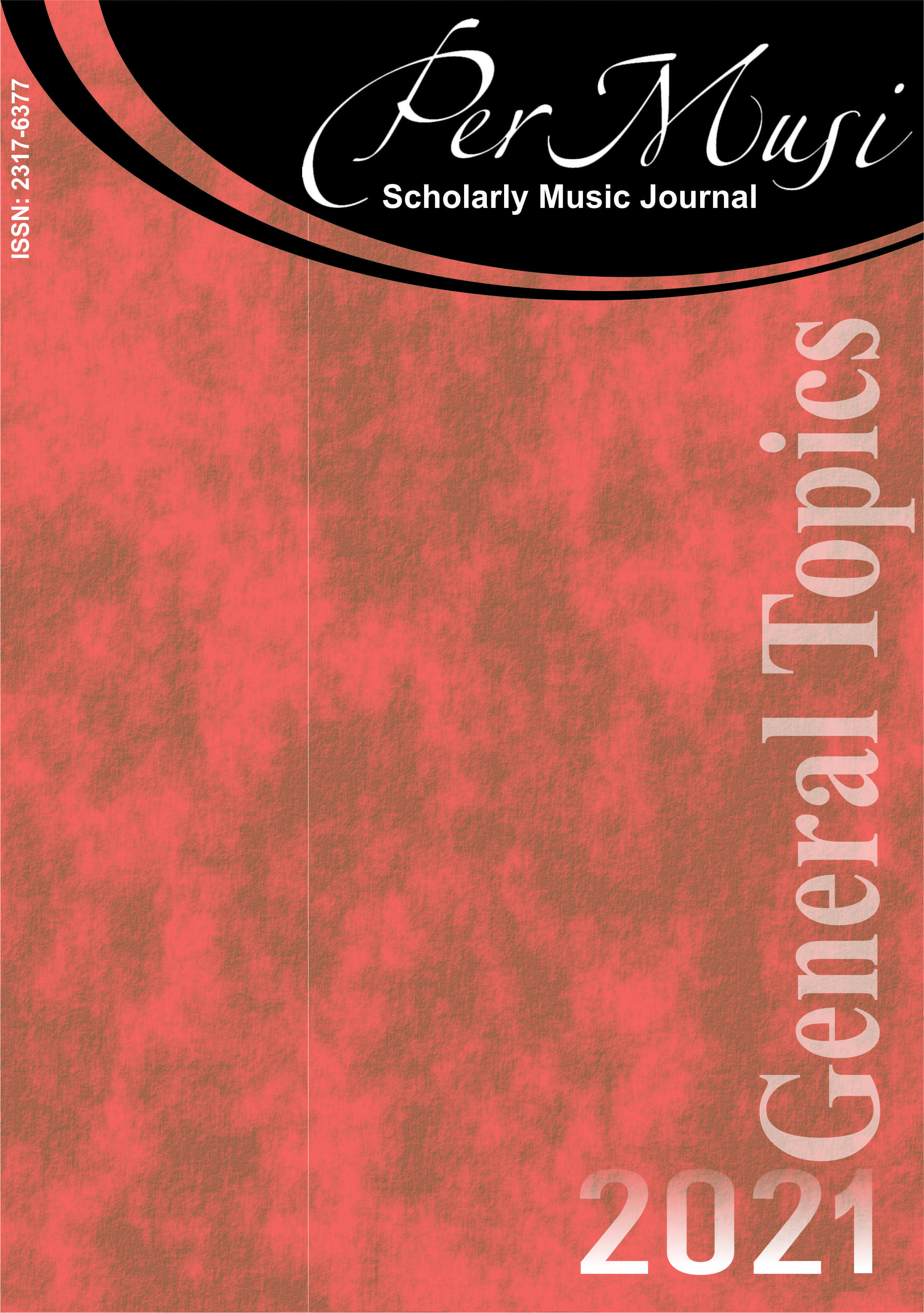The ijexá on guitar grooves
analysis of three cases of popular repertoire
DOI:
https://doi.org/10.35699/2317-6377.2021.26666Keywords:
Ijexá, Rhythm guitar, Brazilian song, Candomblé rhythms, Guitar groovesAbstract
The article consists of an analysis of guitar grooves based on ijexá, a rhythm present in candomblé rituals and which becomes popular outside the terreiros due to the afoxés, carnival parades in Salvador/BA. Questions about the peculiarities of ijexá and its transformation into a popular genre are discussed throughout the text, as well as the relationship between the guitar grooves and the patterns of the rhythm, idiomatic factors and the context of the songs.
Downloads
References
Alípio, Alisson. 2014. Teoria da digitação: um protocolo de instâncias, princípios e perspectivas para a construção de um cenário digitacional ao violão. Porto Alegre: UFRGS.
Amim, Alexandre Gismonti Medeiros. 2017. A polirritmia no violão: uma investigação a partir de 6 peças de Egberto Gismonti. Rio de Janeiro: UFRJ.
Becker, André. 2014. Proposta de treinamento para a improvisação através da rítmica do ijexá. Salvador: UFBA.
Becker, José Paulo. 2013. Levadas brasileiras para violão. Rio de Janeiro: Vitta Books & Music.
Bittar, Iuri Lana. 2011. Jaime Florence (Meira) e sua atividade artística nos grupos Voz do sertão, Regional de Benedito Lacerda e Regional do Canhoto. Rio de Janeiro: UFRJ.
Cardoso, Ângelo Nonato Natale. 2006. A linguagem dos tambores. Salvador: UFBA.
Fonseca, Edilberto José de Macedo. 2003. O toque do gã: tipologia preliminar das linhas- guia o candomblé Ketu-Nagô no Rio de Janeiro. Rio de Janeiro: UNIRIO.
Ikeda, Alberto Tsuyoshi. 2016. "O ijexá no Brasil: rítmica dos deuses nos terreiros, nas ruas e palcos da música popular". Revista USP 111: 21-36.
Koetting, James. 1970. "Analysis and Notation of West African Drum Ensemble Music". Selected Reports 1 (3): 115-146.
Livramento, Natália dos Santos. 2017. O violão no samba: um estudo etnográfico em Florianópolis. Florianópolis: UDESC.
Lopes, Nei. 2005. Partido-alto: Samba de Bamba. Rio de Janeiro: Pallas.
Pereira, Marco. 2007. Ritmos brasileiros. Rio de Janeiro: Garbolights produções artísticas.
Sandroni, Carlos. 2001. Feitiço Decente: Transformações do samba no Rio de Janeiro (1917-1933). Rio de Janeiro: Zahar.
Silva, Felipe Corbani da. 2019. Couros e cordas. Levadas de violão baseadas em toques do candomblé-ketu: ijexá, aderejá e ilu. Florianópolis: UDESC.
Thompson, Robert Farris. 2011. Flash of the spirit: arte e filosofia africana e afro-americana. São Paulo: Museu Afro Brasil.
Verger, Pierre Fatumbi. 1997. Orixás: deuses iorubás na África e no Novo Mundo. Salvador: Corrupio.
Vianna, Hermano. 2012. O mistério do samba. Rio de Janeiro: Zahar.
Vidal Assis. Tratore. [s.d]. Disponível em: <https://tratore.com.br/um_artista.php?id=11386>. Acesso em: 30 de nov. de 2020.
Published
How to Cite
Issue
Section
License
Copyright (c) 2021 Per Musi

This work is licensed under a Creative Commons Attribution 4.0 International License.

Except where otherwise noted, contents on this site are licensed under a Creative Commons - Atribuição 4.0 Internacional.


